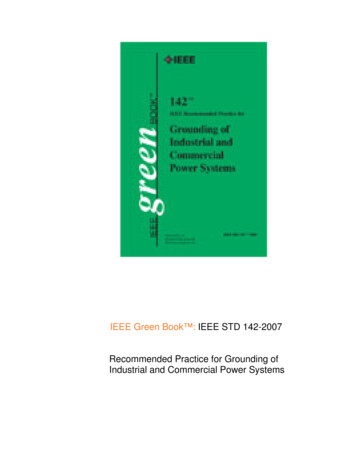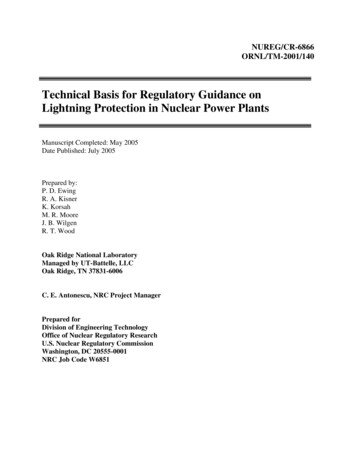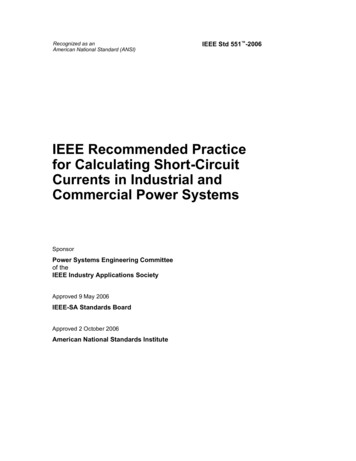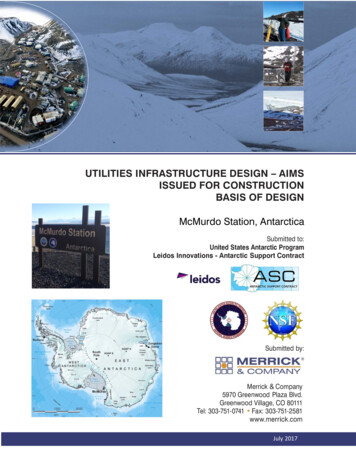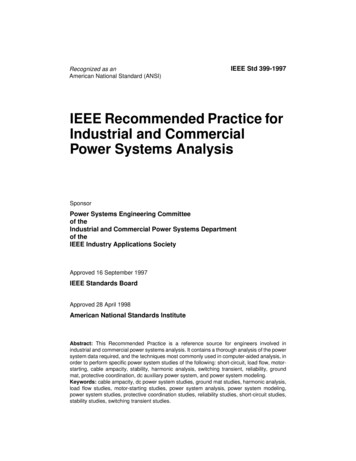
Transcription
Recognized as anAmerican National Standard (ANSI)IEEE Std 399-1997IEEE Recommended Practice forIndustrial and CommercialPower Systems AnalysisSponsorPower Systems Engineering Committeeof theIndustrial and Commercial Power Systems Departmentof theIEEE Industry Applications SocietyApproved 16 September 1997IEEE Standards BoardApproved 28 April 1998American National Standards InstituteAbstract: This Recommended Practice is a reference source for engineers involved inindustrial and commercial power systems analysis. It contains a thorough analysis of the powersystem data required, and the techniques most commonly used in computer-aided analysis, inorder to perform specific power system studies of the following: short-circuit, load flow, motorstarting, cable ampacity, stability, harmonic analysis, switching transient, reliability, groundmat, protective coordination, dc auxiliary power system, and power system modeling.Keywords: cable ampacity, dc power system studies, ground mat studies, harmonic analysis,load flow studies, motor-starting studies, power system analysis, power system modeling,power system studies, protective coordination studies, reliability studies, short-circuit studies,stability studies, switching transient studies.
Grateful acknowledgment is made to the following organization for having granted permission to reprintillustrations in this document as listed below:The General Electric Company, Schenectady, NY, for Figures 16-2, 16-4, 16-6, and 16-7.First PrintingAugust 1998SH94571The Institute of Electrical and Electronics Engineers, Inc.345 East 47th Street, New York, NY 10017-2394, USACopyright 1998 by the Institute of Electrical and Electronics Engineers, Inc.All rights reserved. Published 1998. Printed in the United States of AmericaISBN 1-55937-968-5No part of this publication may be reproduced in any form, in an electronic retrieval system or otherwise,without the prior written permission of the publisher.
IEEE Standards documents are developed within the Technical Committees of the IEEE Societies andthe Standards Coordinating Committees of the IEEE Standards Board. Members of the committeesserve voluntarily and without compensation. They are not necessarily members of the Institute. Thestandards developed within IEEE represent a consensus of the broad expertise on the subject within theInstitute as well as those activities outside of IEEE that have expressed an interest in participating in thedevelopment of the standard.Use of an IEEE Standard is wholly voluntary. The existence of an IEEE Standard does not imply thatthere are no other ways to produce, test, measure, purchase, market, or provide other goods and servicesrelated to the scope of the IEEE Standard. Furthermore, the viewpoint expressed at the time a standardis approved and issued is subject to change brought about through developments in the state of the artand comments received from users of the standard. Every IEEE Standard is subjected to review at leastevery five years for revision or reaffirmation. When a document is more than five years old and has notbeen reaffirmed, it is reasonable to conclude that its contents, although still of some value, do notwholly reflect the present state of the art. Users are cautioned to check to determine that they have thelatest edition of any IEEE Standard.Comments for revision of IEEE Standards are welcome from any interested party, regardless of membership affiliation with IEEE. Suggestions for changes in documents should be in the form of a proposed change of text, together with appropriate supporting comments.Interpretations: Occasionally questions may arise regarding the meaning of portions of standards asthey relate to specific applications. When the need for interpretations is brought to the attention ofIEEE, the Institute will initiate action to prepare appropriate responses. Since IEEE Standards representa consensus of all concerned interests, it is important to ensure that any interpretation has also receivedthe concurrence of a balance of interests. For this reason IEEE and the members of its technical committees are not able to provide an instant response to interpretation requests except in those cases wherethe matter has previously received formal consideration.Comments on standards and requests for interpretations should be addressed to:Secretary, IEEE Standards Board445 Hoes LaneP.O. Box 1331Piscataway, NJ 08855-1331USANote: Attention is called to the possibility that implementation of this standard mayrequire use of subject matter covered by patent rights. By publication of this standard,no position is taken with respect to the existence or validity of any patent rights inconnection therewith. The IEEE shall not be responsible for identifying patents forwhich a license may be required by an IEEE standard or for conducting inquiries intothe legal validity or scope of those patents that are brought to its attention.Authorization to photocopy portions of any individual standard for internal or personal use is granted bythe Institute of Electrical and Electronics Engineers, Inc., provided that the appropriate fee is paid toCopyright Clearance Center. To arrange for payment of licensing fee, please contact Copyright Clearance Center, Customer Service, 222 Rosewood Drive, Danvers, MA 01923 USA; (508) 750-8400. Permission to photocopy portions of any individual standard for educational classroom use can also beobtained through the Copyright Clearance Center.
Introduction(This introduction is not a part of IEEE Std 399-1997, IEEE Recommended Practice for Industrial andCommercial Power Systems Analysis.)This Recommended Practice, commonly known as the “Brown Book,” is intended as apractical, general treatise on power system analysis theory and as an engineer’s referencesource on the techniques that are most commonly applied to the computer-aided analysis ofelectric power systems in industrial plants and commercial buildings. The Brown Book is auseful supplement to several other power system analysis texts that appear in the referencesand bibliography subclauses of the various chapters of this book. The Brown Book is bothcomplementary and supplementary to the rest of the Color Book series.One new and important chapter has been added: Chapter 16, entitled “DC auxiliary powersystem analysis.” All the other chapters in this new edition have been revised and updated—in some cases quite substantially—to reflect current technology.To many members of the working group who wrote and developed this RecommendedPractice, the Brown Book has become a true labor of love. The dedication and support ofeach individual member is clearly evident in every chapter of the Brown Book. Theseindividuals deserve our many thanks for their excellent contributions.iv
The Brown Book Working Group for the 1997 edition had the following membership:L. Guy Jackson, ChairChapter 1:Introduction—L. Guy Jackson, Chair; George A. TerryChapter 2:Applications of power system analysis—L. Guy Jackson, Chair;George A. TerryChapter 3:Analytical procedures—M. Shan Griffith, Chair; Anthony J. RodolakisChapter 4:System modeling—Stephen S. Miller, Co-Chair; Mark Halpin; Co-Chair;Matt McBurnett; Anthony J. Rodolakis; Michael S. TuckerChapter 5:Computer solutions and systems—Glenn E. Word, Chair; Anthony J. RodolakisChapter 6:Load flow studies—Chet E. Davis, Co-Chair; James W. Feltes, Co-Chair;Mark Halpin; Anthony J. RodolakisChapter 7:Short-circuit studies—Anthony J. Rodolakis, Chair; William M. Hall;Mark Halpin; Michael E. Lick; Matt McBurnett; Conrad St. PierreChapter 8:Stability studies—Wei-Jen Lee, Co-Chair; Mark Halpin, Co-Chair;Matt McBurnett; Anthony J. RodolakisChapter 9:Motor-starting studies—M. Shan Griffith, Co-Chair; Mike Aimone, Co-Chair;Anthony J. RodolakisChapter 10: Harmonic analysis studies—Suresh C. Kapoor, Chair; M. Shan Griffith;Mark HalpinChapter 11: Switching transient studies—Carlos B. Pinheiro, ChairChapter 12: Reliability studies—Michael R. Albright, ChairChapter 13: Cable ampacity studies—Farrokh Shokooh, ChairChapter 14: Ground mat studies—M. Shan Griffith, Chair; Anthony J. RodolakisChapter 15: Coordination studies—A. Elizabeth Ronat, Chair; Mike Aimone;Michael E. Lick; John F. WitteChapter 16: DC auxiliary power system analysis—Kenneth Fleishcher, Co-Chair;Scott Munnings, Co-Chair; Ajkit K. Hiranandani; Gene A. PolettoOthers who contributed to the development of this document are as follows:J. J. DiaC. R. HeisingA. D. PattonDavid ShippGeorge W. WalshErzhuan Zhouv
The following persons were on the balloting committee:Mike A. AimoneMichael R. AlbrightRobert J. BeakerReuben F. Burch IVChet DavisJames W. FeltesLandis H. FloydJerry M. FrankDan GoldbergM. Shan GriffithWilliam M. HallMark S. HalpinL. Guy JacksonSuresh C. KapoorviDon O. KovalWei-Jen LeeMichael E. LickMatt McBurnettRichard H. McFaddenReg MendisSteve S. MillerDaleep MohlaWilliam J. MoylanR. Scott MunningsAndrew T. MorrisEd PalkoGene A. PolettoBrian RenerRasheek RifaatMilton D. RobinsonAnthony RodolakisA. Elizabeth RonatDonald R. RuthmanVincent SaporitaLynn F. SaundersStan ShillingDavid ShippFarrokh ShokoohConrad R. St. PierreErzhuan ZhouDonald W. Zipse
When the IEEE Standards Board approved this standard on 16 September 1997, it had thefollowing membership:Donald C. Loughry, ChairRichard J. Holleman, Vice ChairAndrew G. Salem, SecretaryClyde R. CampStephen L. DiamondHarold E. EpsteinDonald C. FleckensteinJay Forster*Thomas F. GarrityDonald N. HeirmanJim IsaakBen C. JohnsonLowell JohnsonRobert KenellyE.G. “Al” KienerJoseph L. Koepfinger*Stephen R. LambertLawrence V. McCallL. Bruce McClungMarco W. MigliaroLouis-François PauGerald H. PetersonJohn W. PopeJose R. RamosRonald H. ReimerIngo RüschJohn S. RyanChee Kiow TanHoward L. Wolfman*Member EmeritusAlso included are the following nonvoting IEEE Standards Board liaisons:Satish K. AggarwalAlan H. CooksonPaula M. KeltyIEEE Standards Project EditorNational Electrical Code and NEC are both registered trademarks of the National Fire Protection Association, Inc.vii
ContentsChapter 1Overview. 11.1 Scope and general information . 11.2 History of power system studies . 11.3 Applying power system analysis techniques to industrial andcommercial power systems . 21.4 Purposes of this Recommended Practice . 21.5 References . 5Chapter 2Applications of power system analysis. on . 7Load flow analysis . 7Short-circuit analysis. 8Stability analysis . 8Motor-starting analysis . 8Harmonic analysis. 9Switching transients analysis . 10Reliability analysis . 10Cable ampacity analysis. 10Ground mat analysis. 11Protective device coordination analysis . 11DC auxiliary power system analysis . 12Chapter 3Analytical procedures . 133.1 Introduction . 133.2 Fundamentals . 143.3 Bibliography. 40Chapter 4System modeling. 434.14.24.34.44.54.64.74.84.9Introduction . 43Modeling . 43Review of basics . 44Power network solution . 49Impedance diagram . 53Extent of the model . 54Models of branch elements . 55Power system data development . 71Models of bus elements. 80ix
4.10 References . 994.11 Bibliography. 100Chapter 5Computer solutions and systems. 1035.15.25.35.4Introduction . 103Numerical solution techniques. 104Computer systems . 122Bibliography. 129Chapter 6Load flow studies. 1336.16.26.36.46.56.66.76.8Introduction . 133System representation . 134Input data. 137Load flow solution methods. 140Load flow analysis . 149Load flow study example . 151Load flow programs . 162Conclusions . 162Chapter 7Short-circuit studies . 1657.17.27.37.47.57.67.77.87.9Introduction and scope . 165Extent and requirements of short-circuit studies. 166System modeling and computational techniques . 168Fault analysis according to industry standards . 172Factors affecting the accuracy of short-circuit studies. 179Computer solutions . 182Example . 187References . 203Bibliography. 206Chapter 8Stability studies. 2098.18.28.38.48.58.68.78.88.9xIntroduction . 209Stability fundamentals. 209Problems caused by instability. 216System disturbances that can cause instability. 216Solutions to stability problems. 217System stability analysis . 218Stability studies of industrial power systems . 223Summary and conclusions . 228Bibliography . 229
Chapter 9Motor-starting studies . 2319.19.29.39.49.59.69.79.89.9Introduction . 231Need for motor-starting studies. 231Recommendations . 235Types of studies . 237Data requirements . 238Solution procedures and examples. 241Summary . 259References . 263Bibliography. 263Chapter 10Harmonic analysis studies. uction . 265Background . 266Purpose of harmonic study. 267General theory. 268System modeling. 276Example solutions . 290Remedial measures . 302Harmonic standards. 307References . 309Bibliography. 309Chapter 11Switching transient studies . 31311.111.211.311.411.511.6Power system switching transients . 313Switching transient studies. 338Switching transients—field measurements . 359Typical circuit parameters for transient studies . 363References . 367Bibliography. 367Chapter 12Reliability studies. 37512.212.312.412.512.6Definitions. 375System reliability indexes . 377Data needed for system reliability evaluations . 377Method for system reliability evaluation . 378References . 380xi
Chapter 13Cable ampacity studies . 38313.113.213.313.413.513.613.713.8Introduction . 383Heat flow analysis . 384Application of computer program. 386Ampacity adjustment factors . 388Example . 399Conclusion . 403References . 404Bibliography. 404Chapter 14Ground mat studies . ntroduction . 407Justification for ground mat studies . 407Modeling the human body . 407Traditional analysis of the ground mat . 410Advanced grid modeling . 415Benchmark problems . 418Input/output techniques. 420Sample problem . 420Conclusion . 420Reference . 423Bibliography. 424Chapter 15Coordination studies . n . 429Basics of coordination. 430Computer programs for coordination. 435Common structure for computer programs . 436How to make use of coordination software. 441Verifying the results. 443Equipment needs . 443Conclusion . 444Bibliography. 444Chapter 16DC auxiliary power system analysis. 44516.116.216.316.4xiiIntroduction . 445Purpose of the recommended practice . 445Application of dc power system analysis. 445Analytical procedures . 446
16.516.616.716.816.9System modeling. 446Load flow/voltage drop studies. 461Short-circuit studies . 464International guidance on dc short-circuit calculations . 466Bibliography. 466Index . 469xiii
IEEE Recommended Practice for Industrial andCommercial Power Systems AnalysisChapter 1Overview1.1 Scope and general informationThis Recommended Practice, commonly known as the IEEE Brown Book, is published bythe Institute of Electrical and Electronics Engineers, Inc. (IEEE) as a reference source to giveplant engineers a better understanding of the purpose for and techniques involved in powersystem studies. The IEEE Brown Book can also be a helpful reference source for system anddata acquisition for engineering consultants performing necessary studies prior to designing anew system or expanding an existing power system. This Recommended Practice will helpensure high standards of power system reliability and maximize the utilization of capitalinvestment.The IEEE Brown Book emphasizes up-to-date techniques in system studies that are mostapplicable to industrial and commercial power systems. It complements the other IEEE ColorBooks, and is intended to be used in conjunction with, not as a replacement for, the manyexcellent texts available in this field.The IEEE Brown Book was prepared on a voluntary basis by engineers and designers functioning as a Working Group within the IEEE, under the Industrial and Commercial PowerSystems Department of the Industry Applications Society.1.2 History of power system studiesThe planning, design, and operation of a power system requires continual and comprehensiveanalyses to evaluate current system performance and to establish the effectiveness of alternative plans for system expansion.The computational work to determine power flows and voltage levels resulting from a singleoperating condition for even a small network is all but insurmountable if performed
Power Systems Engineering Committee of the Industrial and Commercial Power Systems Department of the IEEE Industry Applications Society Approved 16 September 1997 IEEE Standards Board Approved 28 April 1998 American National Standards Institute Abstract: This Recommended Practice is a reference source for engineers involved in industrial and .



